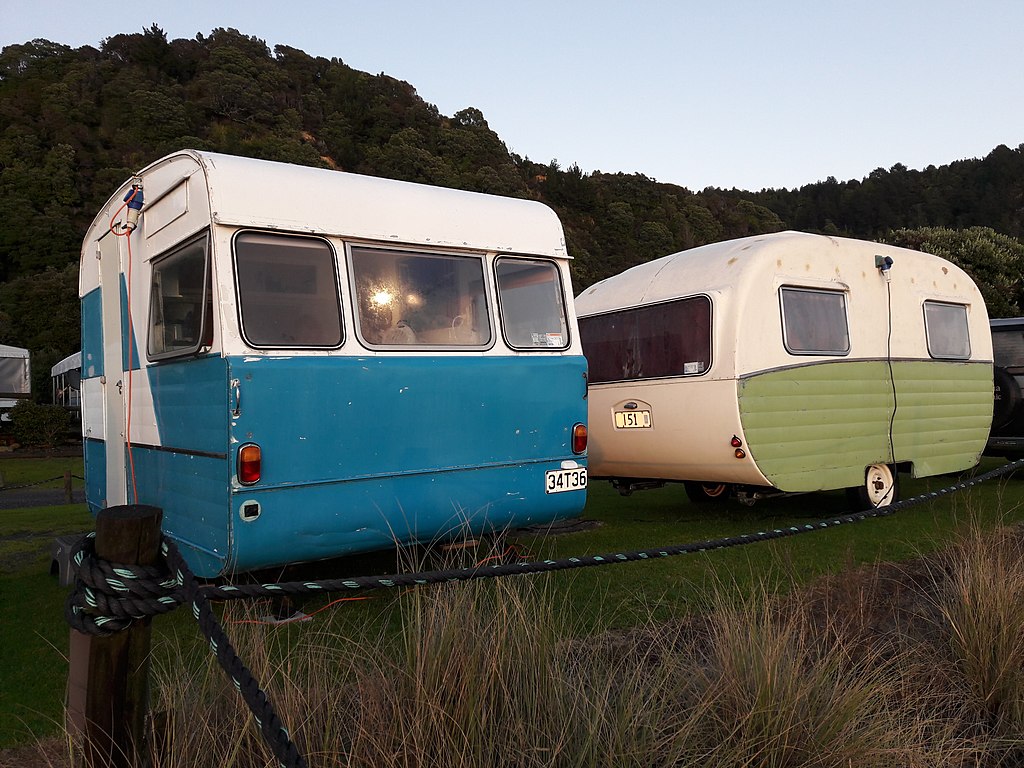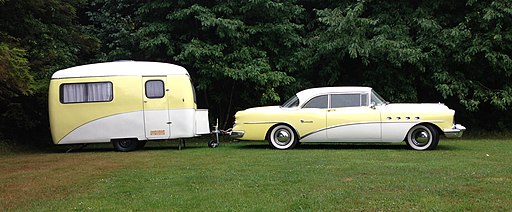Cover image from
Caravanning is a wonderful adventure, the open road, the endless horizons. The thing is, you really need to go about it safely.
To do that, there seems to be so much to consider from hitching a caravan correctly, to manoeuvring it into position at the campsite, or just towing it down the road. Here’s the low-down on getting that done and staying safe while caravanning. And staying safe starts before you even leave home.
At home.
The caravan is planted in your driveway. You’ve had it serviced, your car serviced and planned your route. Then comes the time to load your van. That means getting the tins of beans packed away with the Vegemite, making sure the gas is filled, putting some water in the tanks, stowing the wine, folding and cramming the clothes into a drawer or cupboard. However, loading the caravan is not quite that simple.
Here are some tips:

Image: 19Brookwood60, CC BY-SA 4.0 <https://creativecommons.org/licenses/by-sa/4.0>, via Wikimedia Commons
When loading your van, it’s essential to keep your van’s centre of gravity low. You do that by putting heavy items near the floor and wherever possible over the axles.
It is important that you know your ATM/GTM and ball weight is not exceeded. You need to meet all tow vehicle and tow bar specifications. If you do exceed the ball load, don’t just move a chunk of your gear to the rear of the van. Excess load at the rear of the caravan this will affect the stability.
Some caravans have greater weight on one side because of the fridge, stove, kitchen and dinette. Try to Balance this out by loading portable equipment on the other side.
Remember caravan camping is not necessarily about taking home away to another location. It’s about finding a new adventure. That in mind, remove unnecessary items and use lightweight items wherever possible to reduce the caravan’s weight and save on fuel.
Sometimes the little things matter. Rubber matting or foam on shelves will stop the contents from sliding.
Don’t arrive in your destination to find that your cupboards are full of broken stuff. Wrap glassware and other breakables in towels or newspapers. Use plastics where possible.
Some tips almost seem too simple. This is one. Don’t leave loose articles on the floor where they can roll around and cause damage.
Store food and equipment that you will need when you first stop within easy reach.
Carry all the tools and equipment you need for hitching and unhitching in an easy-to-access place.
Load levelling devices
Load levelling devices redistribute the load between the front and rear axles of the tow vehicle for greater stability, steering response and braking. Before buying one, know that:
They DO NOT reduce the ball load of the caravan
They should only be used on tow bars and vehicles that are intended for them, or else they may cause structural failure
You should seek specialist advice from the licensed dealer or a caravan parts retailer or supplier before fitting a load levelling device.
Extension mirrors
When it comes to mirrors, no matter what style you choose, the tow mirrors must achieve one thing. They must allow you to see the cars behind you on both sides.
Hitching up

Hitching the car is arguably the biggest cause of tension on caravanning adventures. Excuse the simple pun, but you can hitch without too much of a hitch. Here’s a few things to remember.
It is possible that your tow vehicle will get your rig moving better if you start with it warm. Don’t annoy the neighbours by letting your whooping big tow vehicle sit and idle for 15 minutes before hooking up. Your park neighbour won’t thank you if their annex is full of diesel fumes. You could consider taking the ute or SUV for a short drive.
Apply the van brake and raise the van’s corner stabilisers
Using the jockey wheel, ensure the front of the van is raised high enough to allow the tow ball to pass under the coupling.
Practice and agree on any hand signals that will be used by the assistant.
Make sure the assistant stands clear of the car’s reversing path.
Do not argue.
Once the tow ball is in place under the coupling, lower the jockey wheel to mate the parts; then connect the safety chain, electrical, load levelling hitch and brakes and remove or stow the jockey wheel
Release the trailer’s handbrake.
The check list
Before taking to the road at any time, ensure that:
Corner stabilisers are up and jockey wheel is stowed
Coupling lock mechanism is firmly fixed
Safety chains are attached
Brake coupling / wiring is connected
Light wiring has been connected to the car and the lights are working
Tyre pressures of car and van are correct
Wheel chocks are removed
Windows and hatches are closed and locked
Van step is retracted
Electricity lead, water and sullage hoses are disconnected and stowed
Inside, cupboard doors are closed and movable objects are packed to prevent sliding around
Gas is off and fridge is turned over to 12v supply if fitted (note: gas pilot lights must be turned off when refuelling the towing vehicle)
The TV antenna is removed or retracted
The caravan door is locked and safely latched
Outside rear vision mirrors have been adjusted and the windscreen has been cleaned
Do you have any other tips? Drop us an email.
The information provided here is intended as a general guide only. You should carry out further research and investigations into the topics outlined above prior to implementing any actions or recommendations.
Tips for better carvanning